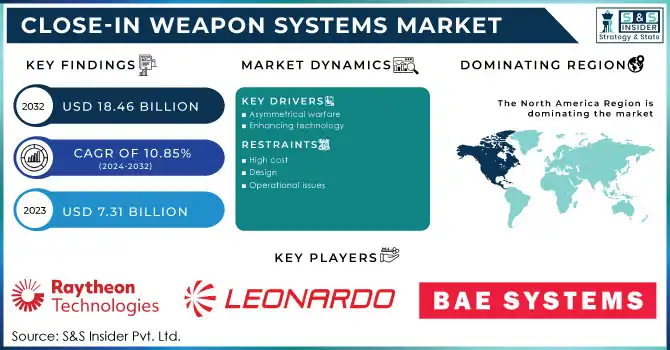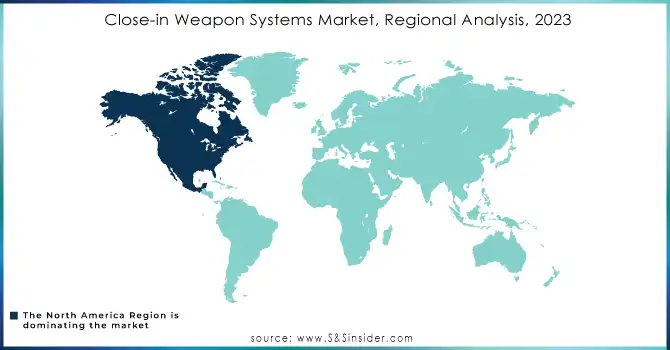Close-in Weapon Systems Market Report Scope & Overview:

To get more information on Close-In Weapon Systems Market - Request Free Sample Report
The Close-in Weapon Systems Market size was USD 7.31 billion in 2023 and is expected to reach USD 18.46 billion by 2032 and grow at a CAGR of 10.85% over the forecast period of 2024-2032.
As the need for CIWS programs is direct support for the continuous acquisition and development of a wild armada of international and shipping platforms, it is significantly affected by the approved international defense budget. Therefore, the COVID-19 epidemic has had a moderate impact on the target market. The ongoing global economic downturn is expected to have the effect of declining defense spending in the short term. However, because of existing regulations and regulators, major US-based producers are less likely to bear the brunt of the widespread disruption of the supply chain caused by the epidemic.
However, MRO suppliers and MRO service providers in Asia-Pacific and South America are at high risk of supply disruption and it is thought that they will face operational challenges and significant financial exposure due to supply chain restrictions. The close-knit arms market is expected to be driven by a steady increase in global military exports, internal and external security threats, technological advancements, aging international warships, collaborative operations, and strategic alliances designed to address the specific needs of modern international military programs. In addition, the growing conditions of asymmetric warfare and the emphasis on developing advanced military systems are at the forefront of the market. However, design and operational problems related to the use of automatic weapons such as remote weapon systems and CIWS may be a challenge for the industry in the short term. In addition, the market is marred by frequent installations and operational challenges associated with independent weapons systems, such as the natural vulnerability of magnetic fields, radio signals, and other electronic attacks.
MARKET DYNAMICS:
KEY DRIVERS
-
Asymmetrical warfare
-
Enhancing technology
RESTRAINTS
-
High cost
-
Design
-
Operational issues
OPPORTUNITIES
-
Enhance Short Range Radar
CHALLENGES
-
Installation
-
Natural vulnerability
THE IMPACT OF COVID-19
Because the demand for CIWS programs is a direct result of the continuous procurement and development of fixed weapons for global and military platforms, the international military budget approved annually has a significant impact. As a result, the COVID-19 epidemic has only had a small impact on the market when considered. On a short-term basis, the ongoing global economic downturn is expected to lead to a reduction in defense costs. On the other hand, large US-based firms are less likely to be affected by the massive disruption of supply of the epidemic due to current laws and restrictions. On the other hand, MRO providers and service providers in Asia-Pacific and South America, are at high risk of supply chain disruption and are expected to face operational problems and high financial risk exposure due to supply chain problems.
MARKET ESTIMATIONS
By Armament(mm)
The market is segmented into four different types 20mm, 30mm, & 35mm, 40mm, and other
The company is a leading manufacturer of medium- and large-caliber tactical and training ammunition for the United States and its allies. Looking forth, Northrop Grumman is at the forefront of growing new, advanced ammunition types such as enhanced armor penetration, proximity fuzed, air bursting, and multipurpose warheads for systems ranging from 20mm to 120mm in order to enhance the capabilities of weapon systems to meet peer and near-peer threats. Medium caliber ammunition advancements include air bursting and the development of a new, proximity fuzed warhead for 30mm x 113mm ammunition, which will increase the Apache attack helicopter's ability to engage air to ground and air to air targets. Once completed, the technology will be scaled to multiple medium caliber types to provide precision, bursting warhead to air, land, and sea weapons systems. The advancement of the proximity fuse will also result in the development of medium caliber guided ammunition, which will provide the precision required to engage moving targets and defeat unmanned threats.
By Type
The market is segmented into two different types Gun based CIWS, Missile CIWS, Guns, missiles, torpedoes, and close-in weapon systems (CIWS) are just a few of the names in the Indian Navy's treasure chest. The world's seventh most powerful navy is also getting closer to acquiring directed-energy weapons. DEWs, which are classified as either high-powered lasers or microwaves, are expected to destroy enemy missiles, aircraft, and Remotely Piloted Aircraft/Unmanned Aerial Vehicles based on electronic circuitry. is the last line of defense against any short-range hostile threat above the waterline, and experts believe it should be a combination of missiles and guns to be truly effective. The CIWS gun mount moves quickly and precisely, enabling the system's defensive capabilities against incoming targets and threats.
By Technology
The market is segmented into six different types such as Radar, Active Homing, Passive Homing, Infrared, IIR Homing, IR Homing, Others
Radar is the company's go-to tool for informed technology management and strategic decision-making about which technological directions to pursue and which to avoid.
Infrared radiation is used in a variety of applications, including thermal imaging cameras, remote controls, fiber optic cables, infrared astronomy, and meteorology.
Active homing is a missile guidance method in which a missile is equipped with a radar transceiver and the electronics required to find and track its target autonomously.
Many passive homing missiles have an additional capability: if the target attempts to use noise jamming, the missile can passively home in on the target's radiation (home-on-jam). This improves the performance of such missiles against noise jamming targets and allows anti-aircraft munitions to attack targets that they would not otherwise be able to attack effectively.
By Platform
The market is segmented into two types Land-based CIWS and Naval as on land, CIWS are used to protect military bases. The CIWS can also protect the base from shell and rocket fire in this case. C-RAM is another form of CIWS that is used on land. On a smaller scale, active protection systems are being developed for use in some tanks to destroy rocket-propelled grenades (RPGs). In the early 1980s, the Drozd system was used on Soviet Naval Infantry tanks, but it was later replaced by explosive reactive amour.
COMPETITIVE LANDSCAPE
The Close-In Weapon Systems market is comprised of major players such as Raytheon Technologies Corporation, Leonardo Spa, BAE Systems plc, Rheinmetall AG, ASELSAN AS, and Thales Group, who hold market share. The growing demand for CIWS promotes the R&D of new optronics and underlying sensory systems. At the same time, companies are trying to expand their presence in emerging markets such as Asia-Pacific. ASELSAN AS’s Gokdeniz CIWS was introduced to an undisclosed country in the region. Gokdeniz CIWS operates against helicopters, fighter jets, unmanned aerial vehicles, and over asymmetric naval threats. the Indian Defense Ministry awarded a tender of more than USD 1.5 billion to acquire 61 units of CIWS from domestic producers under the Make in India program. Under the plan, Indian companies will have to work with foreign manufacturers to develop weapons systems under the 'purchase and manufacture' clause of the defense acquisition process.
KEY MARKET SEGMENTATION
By Armament
-
20
-
30
-
35
-
40
-
Others
By type
-
Gun-based CIWS
-
Missile CIWS
By Technology
-
Radar
-
Active Homing
-
Passive Homing
-
Infrared
-
IIR Homing
-
IR Homing
-
Others
By Platform
-
Land-based CIWS
-
Naval
Regional Analysis:
The United States and Canada are active users of CIWS in North America who are currently focused on improving their existing vehicles and their compact capabilities. The US defense priorities modernization of military systems to compete with China and Russia globally while emphasizing the day-to-day operation of ongoing conflicts, disaster response, and cooperation. defense contractors are expected to pursue the production of existing CIWS while doing comprehensive R&D for future plans. Raytheon Technologies Corporation was awarded a $ 482 million six-year contract to renew the MK 15 CIWS used by the US Army and the US Army. Raytheon received a $ 570 million contract from the Canadian government for the maintenance and upgrading of 21 Phalanx Close-in Weapon Systems units installed on a warship. Contract provisions include engineering services, project management, support, and disposal services, and procurement of test equipment and tools until 2037. In addition, US Navy awarded a $ 200 million contract to Raytheon Technologies Corporation for the MK 15 Close-In Weapon System for the development, modification, refurbishment, and associated computer systems of U.S. and international. Many procurement and development plans are expected to be launched in the future and are expected to improve business prospects in the North American market segment with a focus on forecasting time.

Need any customization research on Close-in Weapon Systems Market - Enquiry Now
REGIONAL COVERAGE:
North America
-
USA
-
Canada
-
Mexico
Europe
-
Germany
-
UK
-
France
-
Italy
-
Spain
-
The Netherlands
-
Rest of Europe
Asia-Pacific
-
Japan
-
South Korea
-
China
-
India
-
Australia
-
Rest of Asia-Pacific
The Middle East & Africa
-
Israel
-
UAE
-
South Africa
Rest of Middle East & Africa
-
Latin America
-
Brazil
-
Argentina
-
Rest of Latin America
KEY PLAYERS
The Key Players are Raytheon Technologies Corporation, Leonardo Spa, BAE Systems plc, Rheinmetall AG, ASELSAN AS, Thales Group & Other Players
| Report Attributes | Details |
|---|---|
| Market Size in 2023 | US$ 7.31 Billion |
| Market Size by 2032 | US$ 18.46 Billion |
| CAGR | CAGR of 10.85% From 2024 to 2032 |
| Base Year | 2023 |
| Forecast Period | 2024-2032 |
| Historical Data | 2020-2022 |
| Report Scope & Coverage | Market Size, Segments Analysis, Competitive Landscape, Regional Analysis, DROC & SWOT Analysis, Forecast Outlook |
| Key Segments | • By Type (Gun-based System, Missile-based System) • By Platform (Land-based, Naval-based) • By Armament (20 mm, 30 mm, 35 mm, 40 mm, Others) • By Technology (Radar, Active Homing, Passive Homing, Infrared, Others) |
| Regional Analysis/Coverage | North America (USA, Canada, Mexico), Europe (Germany, UK, France, Italy, Spain, Netherlands, Rest of Europe), Asia-Pacific (Japan, South Korea, China, India, Australia, Rest of Asia-Pacific), The Middle East & Africa (Israel, UAE, South Africa, Rest of Middle East & Africa), Latin America (Brazil, Argentina, Rest of Latin America) |
| Company Profiles | Raytheon Technologies Corporation, Leonardo Spa, BAE Systems plc, Rheinmetall AG, ASELSAN AS, and Thales Group |
| Key Drivers | • Asymmetrical warfare • Enhancing technology |
| RESTRAINTS | • High cost • Design • Operational issues |

